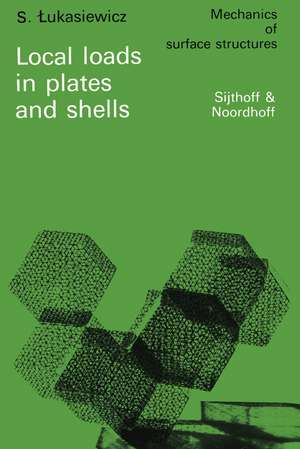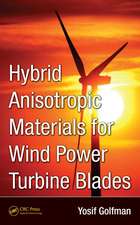Local loads in plates and shells: Mechanics of Surface Structure, cartea 4
Autor S. Lukasiewiczen Limba Engleză Paperback – 21 dec 2011
Preț: 653.33 lei
Preț vechi: 768.62 lei
-15% Nou
Puncte Express: 980
Preț estimativ în valută:
125.01€ • 130.88$ • 103.44£
125.01€ • 130.88$ • 103.44£
Carte tipărită la comandă
Livrare economică 05-19 aprilie
Preluare comenzi: 021 569.72.76
Specificații
ISBN-13: 9789400995437
ISBN-10: 9400995431
Pagini: 588
Ilustrații: 588 p.
Dimensiuni: 152 x 229 x 31 mm
Greutate: 0.78 kg
Ediția:Softcover reprint of the original 1st ed. 1979
Editura: SPRINGER NETHERLANDS
Colecția Springer
Seria Mechanics of Surface Structure
Locul publicării:Dordrecht, Netherlands
ISBN-10: 9400995431
Pagini: 588
Ilustrații: 588 p.
Dimensiuni: 152 x 229 x 31 mm
Greutate: 0.78 kg
Ediția:Softcover reprint of the original 1st ed. 1979
Editura: SPRINGER NETHERLANDS
Colecția Springer
Seria Mechanics of Surface Structure
Locul publicării:Dordrecht, Netherlands
Public țintă
ResearchCuprins
1 Basic equations of the theory of plates and shells.- 1.1 A short introduction to the tensor calculus.- 1.2 Strains and displacements of a three-dimensional body.- 1.3 Stresses and equilibrium equations of a three-dimensional body.- 1.4 Fundamental assumptions in the theory of plates and shells.- 1.5 Some fundamental results from the theory of surfaces.- 1.5.1 First metric tensor.- 1.5.2 The physical components.- 1.5.3 The metric tensor of the curvature.- 1.6 The geometry of the shell.- 1.7 Deformation of the shell.- 1.8 Constitutive equations, equations of equilibrium.- 1.9 Effect of transverse shear and normal stresses.- 1.10 Compatibility equations.- 1.11 Simplified shell equations.- 1.11.1 Shells of slowly varying curvatures.- 1.11.2 Relations in rectangular coordinates.- 1.11.3 Polar coordinates.- 1.12 Classical theory.- 1.12.1 Shells of slowly varying curvature.- 1.12.2 Shallow shells.- 1.13 Loads tangential to middle surface.- 1.14 The strain energy.- 1.15 Thermal stresses.- 1.16 Orthotropic shells.- 1.16.1 Cylindrical shells. Equations of the classical theory.- 1.16.2 Shallow shells.- 1.16.3 Equations in polar coordinates.- 1.17 The boundary conditions.- 1.18 Sandwich shells.- References 1.- 2 Fundamental equations of plates.- 2.1 Differential equations of isotropic plates.- 2.2 Linear equations.- 2.3 The strain energy of the plate.- 2.4 Variational equations.- 2.5 Boundary conditions for plates.- 2.6 Classical theory of plates under lateral loads.- 2.7 Sandwich plates.- References 2.- 3 Plates under lateral loads at an interior point.- 3.1 Methods of solution.- 3.2 Isotropic circular plate loaded by a concentrated force at its centre.- 3.3 Circular plate with cylindrical orthotropy loaded by a concentrated force.- 3.4 Solutions by means of Fourier series and Fourier integrals.- 3.4.1 Introduction to the theory of distributions.- 3.4.2 Sequence approach.- 3.4.3 Functional approach.- 3.4.4 Methods of integration.- 3.5 Navier solution for the rectangular plate subjected to a concentrated load.- 3.6 Particular solution accomplished by means of Fourier integral.- 3.6.1 Infinite plate.- 3.6.2 Semi-infinite plate and wedge plate.- 3.7 Thick circular plate.- 3.7.1 Equations of the theory of elasticity of the symmetrical body.- 3.7.2 The stresses in a semi-infinite elastic body.- 3.7.3 Axi-symmetrically loaded thick plate.- 3.8 Plate on an elastic foundation.- 3.9 Infinite plate loaded by a concentrated bending moment.- 3.9.1 Moment of two normal forces.- 3.9.2 Concentrated bending moment.- 3.10 Bending moment introduced through a rigid insert.- 3.11 Thermal singularities.- 3.12 Influence surfaces and the Green functions.- 3.12.1 Influence surfaces for the deflection.- 3.12.2 Influence surfaces for the internal moments.- 3.12.3 Singularity and the influence surface for the edge moment of a clamped plate.- 3.13 Plates of various shapes under lateral loads.- 3.13.1 Method of images.- 3.13.2 Singular solutions for semi-infinite and wedge plates.- 3.14 Singularities in the orthotropic plate.- 3.14.1 Solution by means of Fourier integral.- 3.14.2 Solution in a double Fourier series.- 3.14.3 Infinitely long strip plate. Solution by means of single trigonometric series.- 3.15 Singular solutions for sandwich plates.- 3.15.1 Normal force.- 3.15.2 Concentrated bending moment.- References 3.- 4 Concentrated lateral loads at the edge of a plate.- 4.1 Cantilever plate loaded at its free edge by a lateral concentrated force.- 4.2 Plate loaded by a concentrated moment at its free edge.- 4.3 Plate on an elastic foundation loaded at its free edge bya concentrated force.- References 4.- 5 Plates loaded only in their middle plane.- 5.1 General equations.- 5.2 Infinite plate loaded at an interior point by a concentrated force.- 5.3 Circular plate loaded by a tangential load.- 5.4 Infinite orthotropic plate loaded at an interior point.- 5.5 Plates loaded at their edges.- 5.5.1 Concentrated force normal to edge.- 5.5.2 Force tangential to edge.- 5.5.3 Wedge loaded by concentrated force at its apex.- 5.5.4 Wedge loaded by concentrated moment at its apex.- 5.6 Orthotropic plate loaded at free edge.- 5.7 Plates of various shapes under loads in their plane.- References 5.- 6 Plates under lateral loads and loads in the middle plane.- 6.1 Large elastic deflections of a plate.- 6.2 Circular plate.- 6.3 Stability of plates.- 6.3.1 Method of differential equations.- 6.3.2 Energy method.- 6.4 Rectangular plate loaded by compressive forces.- 6.5 Stability of circular plate.- References 6.- 7 Membrane shells under concentrated loads.- 7.1 Shells of revolution.- 7.2 Spherical shell.- 7.3 Conical shell.- References 7.- 8 Spherical shell. Solutions of the general theory.- 8.1 Spherical shell loaded by a concentrated normal force.- 8.2 Spherical shell loaded by a concentrated moment.- 8.3 Spherical shell loaded by a concentrated tangential force.- 8.4 Spherical shell subjected to a twisting moment.- 8.5 The effect of boundary conditions. General solution.- 8.5.1 Shallow shell.- 8.5.2 Non-shallow spherical shell.- References 8.- 9 An arbitrary shell loaded by a normal concentrated force.- 9.1 Deflection and stress function.- 9.2 Stresses in the shell.- 9.3 Solution in polar coordinates.- 9.3.1 Deflection and stress function.- 9.3.2 Internal forces and moments.- 9.3.3 Nearly spherical shell.- 9.4 Load distributed over small surface.- 9.5 Experimental investigation.- 9.6 Simplified solution. Division of loads.- 9.7 Solutions for local load. Shell loaded by a normal concentrated force.- 9.8 The effect of variability of the shell curvature.- 9.9 Method of singular solutions.- 9.10 Load distributed along a small length.- 9.11 Experimental investigation.- 9.12 Conclusions.- References 9.- 10 Shells of cylindrical and nearly cylindrical shape subjected to normal force.- 10.1 The nearly cylindrical shell loaded by two oppositely directed radial forces.- 10.2 Stresses in nearly cylindrical shells.- 10.3 Cylindrical shells.- 10.3.1 General equations of the cylindrical shell.- 10.3.2 Infinitely long shell loaded by two oppositely directed radial forces.- 10.3.3 The cylindrical segment of infinite length.- 10.4 Shallow cylindrical shells.- 10.4.1 Singularities of shallow cylindrical shells.- 10.4.2 Shallow cylindrical shell subjected to hot spot.- 10.5 Effect of boundary conditions.- 10.5.1 General solution of homogeneous equations.- 10.5.2 Shell with simply supported edges.- 10.5.3 The other variant of the solution.- 10.5.4 Solution in double trigonometric series.- 10.5.5 Cylindrical shell with free edges.- 10.6 Cylindrical orthotropic shell.- 10.6.1 Shell with simply supported edges.- 10.6.2 Infinitely long shell.- References 10.- 11 Shells under various concentrated loads.- 11.1 Shell loaded by a concentrated bending moment.- 11.2 The cylindrical shell loaded by a moment distributed over a small surface.- 11.3 Shell loaded by a force tangential to its surface.- 11.3.1 Local loads.- 11.3.2 Solution in polar coordinates.- 11.3.3 The cylindrical shell loaded by a tangential force.- 11.4 Asymptotic relations.- References 11.- 12 Edge loads.- 12.1 Shell loaded at free edge by a lateral force.- 12.1.1 Solution in Fourier integrals.- 12.1.2 Local load.- 12.1.3 Solution by means of Fourier series.- 12.2 Shell loaded by a force normal to the edge and tangential to the middle surface.- 12.3 The shell loaded at its edge by a concentrated bending moment.- References 12.- 13 Large deflections of shells.- 13.1 Spherical shell.- 13.2 Arbitrary shell of positive double curvature.- References 13.- 14 Design of plates and shells under concentrated loads.- 14.1 Infinitely large plate jointed to a long bar and loaded at an interior point.- 14.2 Strip plate jointed with a stringer of finite length.- 14.3 The bar of finite length jointed with an infinite plate.- 14.4 Optimum design of elements introducing the load.- 14.4.1 Bar of variable cross-section.- 14.5 Plate strengthened at the edge by a bar with bending rigidity.- 14.6 An infinite rigid body.- 14.7 A bar of variable rigidity.- 14.8 A plate strengthened by a semi-infinite bar.- 14.9 Optimum design of plates under concentrated forces acting in its middle plane.- 14.9.1 Elastic design.- 14.9.2 Plastic design of plates.- 14.9.3 Design for minimum weight.- 14.9.4 Support for a single force.- 14.10 Design of circular plates under lateral loads.- 14.10.1 Plastic design.- 14.10.2 Circular plate of uniform strength loaded by a lateral concentrated force.- 14.11 Optimum design of shells.- 14.12 Basic equations of the problem.- 14.13 Shells of constant thickness.- 14.14 Design of a shell of variable thickness.- 14.14.1 Shell loaded by a concentrated force and by a pressure.- 14.14.2 Shell carrying its own weight.- 14.15 Experimental design of the shell.- 14.15.1 Designing with liquid analogy.- 14.15.2 Designing in the plastic state.- References 14.- Appendix. Certain remarks on the problem of a concentrated force acting at the edge of the plate.- Tables.- Author index.





















